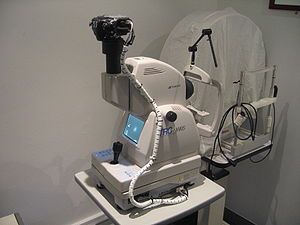Fundus camera

|
WikiDoc Resources for Fundus camera |
|
Articles |
|---|
|
Most recent articles on Fundus camera Most cited articles on Fundus camera |
|
Media |
|
Powerpoint slides on Fundus camera |
|
Evidence Based Medicine |
|
Clinical Trials |
|
Ongoing Trials on Fundus camera at Clinical Trials.gov Trial results on Fundus camera Clinical Trials on Fundus camera at Google
|
|
Guidelines / Policies / Govt |
|
US National Guidelines Clearinghouse on Fundus camera NICE Guidance on Fundus camera
|
|
Books |
|
News |
|
Commentary |
|
Definitions |
|
Patient Resources / Community |
|
Patient resources on Fundus camera Discussion groups on Fundus camera Patient Handouts on Fundus camera Directions to Hospitals Treating Fundus camera Risk calculators and risk factors for Fundus camera
|
|
Healthcare Provider Resources |
|
Causes & Risk Factors for Fundus camera |
|
Continuing Medical Education (CME) |
|
International |
|
|
|
Business |
|
Experimental / Informatics |
Editor-In-Chief: C. Michael Gibson, M.S., M.D. [1]
A fundus camera or retinal camera is a specialized low power microscope with an attached camera designed to photograph the interior surface of the eye, including the retina, optic disc, macula, and posterior pole (i.e. the fundus).[1][2]
Fundus cameras are used by optometrists, ophthalmologists, and trained medical professionals for monitoring progression of a disease, diagnosis of a disease (combined with retinal angiography), or in screening programs, where the photos can be analysed later.
Optical principles
The optical design of fundus cameras is based on the principle of monocular indirect ophthalmoscopy.[1][2] A fundus camera provides an upright, magnified view of the fundus. A typical camera views 30 to 50 degrees of retinal area, with a magnification of 2.5x, and allows some modification of this relationship through zoom or auxiliary lenses from 15 degrees which provides 5x magnification to 140 degrees with a wide angle lens which minifies the image by half.[2] The optics of a fundus camera is similar to that of an indirect in that the observation and illumination systems follow dissimilar paths. The observation light is focused via a series of lenses through a doughnut shaped aperture, which then passes through a central aperture to form an annulus, before passing through the camera objective lens and through the cornea onto the retina.[3] The light reflected from the retina passes through the un-illuminated hole in the doughnut formed by the illumination system. As the light paths of the two systems are independent, there are minimal reflections of the light source captured in the formed image. The image forming rays continue towards the low powered telescopic eyepiece. When the button is pressed to take a picture, a mirror interrupts the path of the illumination system allow the light from the flash bulb to pass into the eye. Simultaneously, a mirror falls in front of the observation telescope, which redirects the light onto the capturing medium, whether it is film or a digital CCD. Because of the eye’s tendency to accommodate while looking though a telescope, it is imperative that the exiting vergence is parallel in order for an in focus image to be formed on the capturing medium.
Since the instruments are complex in design and difficult to manufacture to clinical standards, only a few manufacturers exist: Topcon, Zeiss, Canon, Nikon, and Kowa.
Applications
Practical instruments for fundus photography perform the following modes of examination:
- Color, where the retina is illuminated by white light and examined in full color.
- Red-free, where the imaging light is filtered to remove red colors, improving contrast of vessels and other structures.
- Angiography, where the vessels are brought into high contrast by intravenous injection of a fluorescent dye. The retina is illuminated with an excitation color which fluoresces light of another color where the dye is present. By filtering to exclude the excitation color and pass the fluorescent color, a very high-contrast image of the vessels is produced. Shooting a timed sequence of photographs of the progression of the dye into the vessels reveals the flow dynamics and related pathologies. Specific methods include sodium fluorescein angiography (abbreviated FA or FAG) and indocyanine green (abbreviated ICG) angiography.
References
- ↑ 1.0 1.1 Cassin, B. and Solomon, S. Dictionary of Eye Terminology. Gainsville, Florida: Triad Publishing Company, 1990.
- ↑ 2.0 2.1 2.2 Saine PJ. "Fundus Photography: What is a Fundus Camera?" Ophthalmic Photographers' Society. Accessed September 30, 2006.
- ↑ Saine PJ. "Fundus Photography: Fundus Camera Optics." Ophthalmic Photographers' Society. Accessed September 30, 2006.
See also
- Dilated fundus examination
- Optical coherence tomography, another method of fundus imaging